African migrants stuck in southern Mexico, their American dream on hold
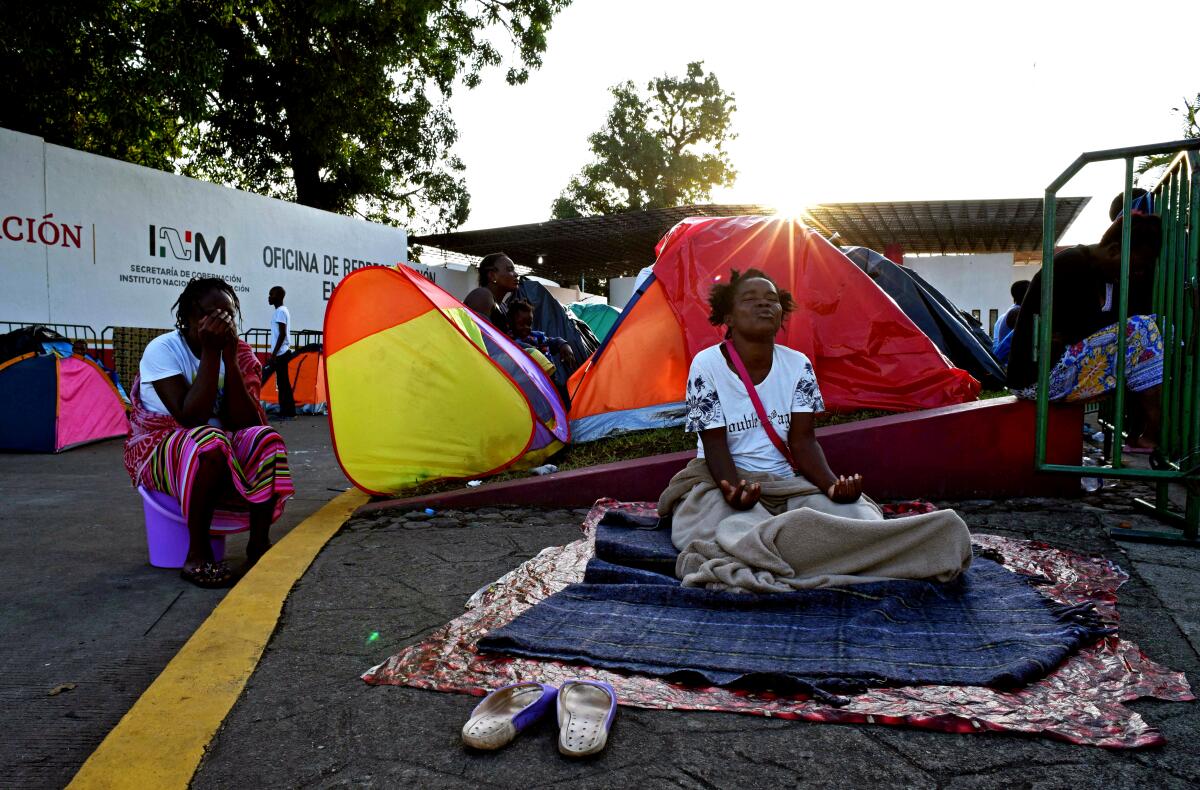
TAPACHULA, Mexico — “Africa weeps. Free us.”
That’s the message handwritten in French and Spanish on a protest banner at a tent city here in the southernmost tip of Mexico.
The tents belong to some 250 African nationals who crossed jungles, forded rivers, sneaked across borders and dodged militias and thieves to get here in hopes of eventually reaching the United States. But now they are stuck, because Mexico has denied them the travel visas necessary to proceed north.
Mexican national guard troops and riot police keep close watch over the multi-hued camp, where mosquitoes swarm in puddles. Rain and a fetid stream provide cooking water and many complain of rashes, stomach cramps and other ailments.
“We are fed up,” said Diop Abou, 33, a native of the northwest African nation of Mauritania. “None of us want to be here in this miserable place.”
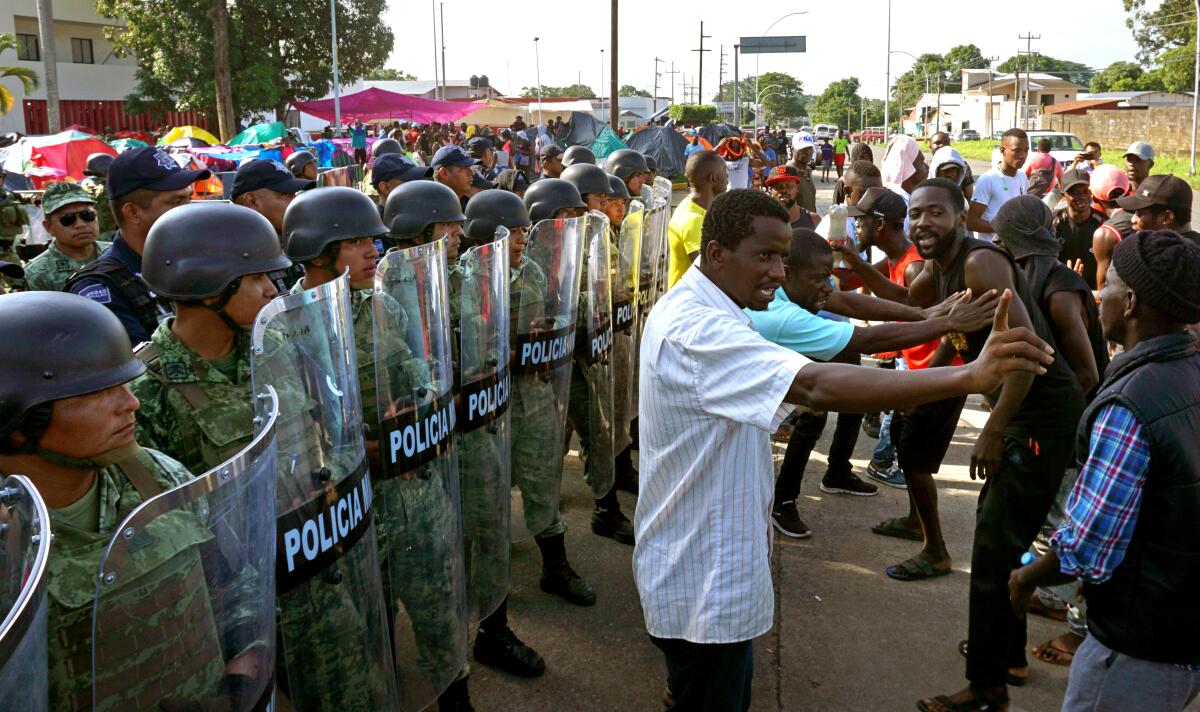
In the saga of migrants trying to reach the United States, the dominant narrative of late features Central Americans, who account for the vast majority of the 100,000 foreigners whom Mexico has deported this year under pressure from the Trump administration to prevent them from reaching the U.S. border.
But Mexico’s effort to accommodate Washington — and avoid tariffs that Trump threatened to impose — has also targeted thousands of other foreigners, including more than 1,000 Africans who have amassed in southern Mexico over the last several months.
The tent city was erected in protest more than a month ago at the entrance of Tapachula’s federal immigrant detention center, which is called Siglo 21, or 21st Century.
The lockup is reserved primarily for people awaiting deportation, mostly Central Americans.
Mexican authorities apprehended a record 4,779 migrants from Africa in the first seven months of this year — nearly four times the number detained during the same period in 2018 — but deported only two.
The difficulty is that many African countries have no embassies or consular representatives here, and some of the migrants possess no verifiable identification. And so the majority remain stranded.
Those interviewed here said they fled violence, persecution and poverty, ethnic and religious strife and political repression back in their homelands.
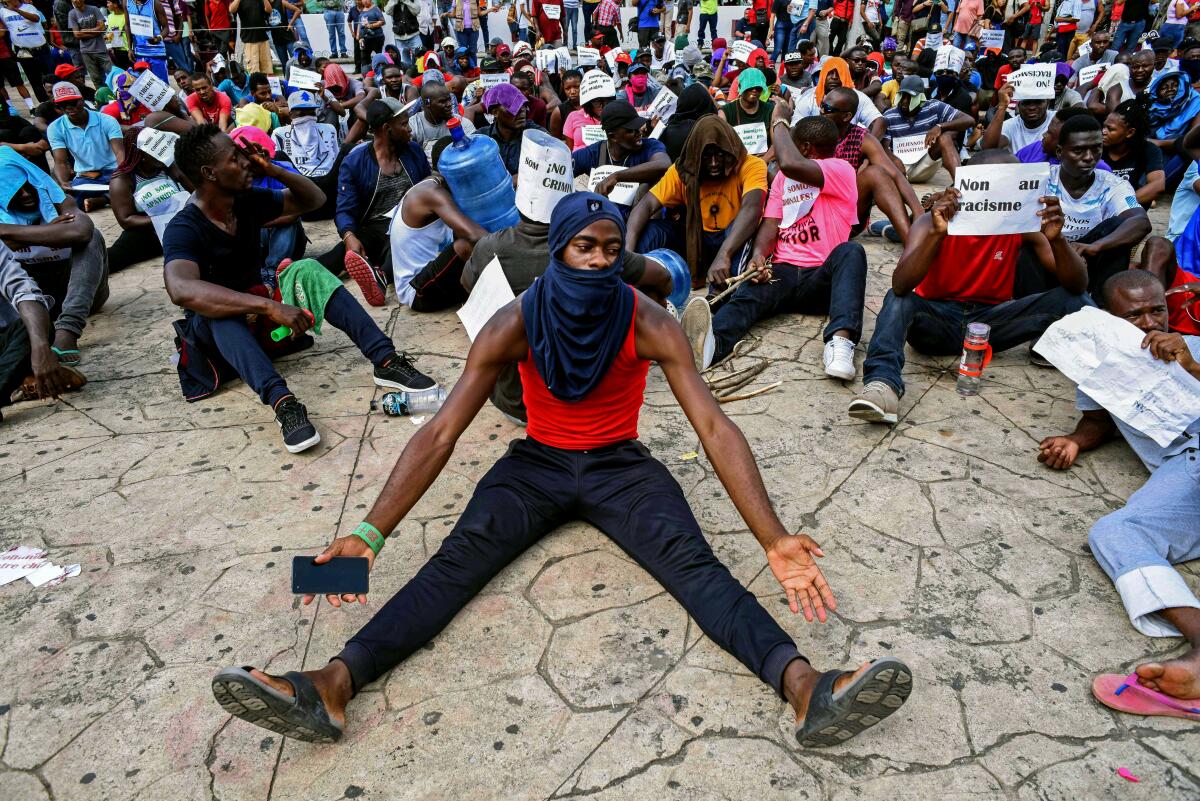
“The military comes after anyone who speaks English,” said Elvis Azo, 29, from Cameroon, a central African country facing both an insurgency among its English-speaking minority and attacks from the Boko Haram Islamist faction. “They burn houses. They kill people.”
Nearby, Sani, 33, said he was among more than a dozen people at the camp who had fled the West African nation of Ghana to escape systematic persecution of gay men.
“They are killing us,” said Sani, who lifted his shirt to reveal scars on his abdomen that he said were a result of being attacked with acid.
He said his family’s home was burned down, and he didn’t want his full name published because he feared for the safety of relatives in Ghana.
“I am a wanted man back home,” he said.
Jack Lume, 33, a tailor from Togo in West Africa, displayed a photograph on his cellphone of a memorial service. The body of a young man lay on white satin inside an open coffin surrounded by mourners.
“That’s my brother,” Lume said. “They killed him. Politics, politics. They kill people.”
The Africans embarked in search of what many call “the American dream” after hearing about migrants who reached the United States through Mexico.
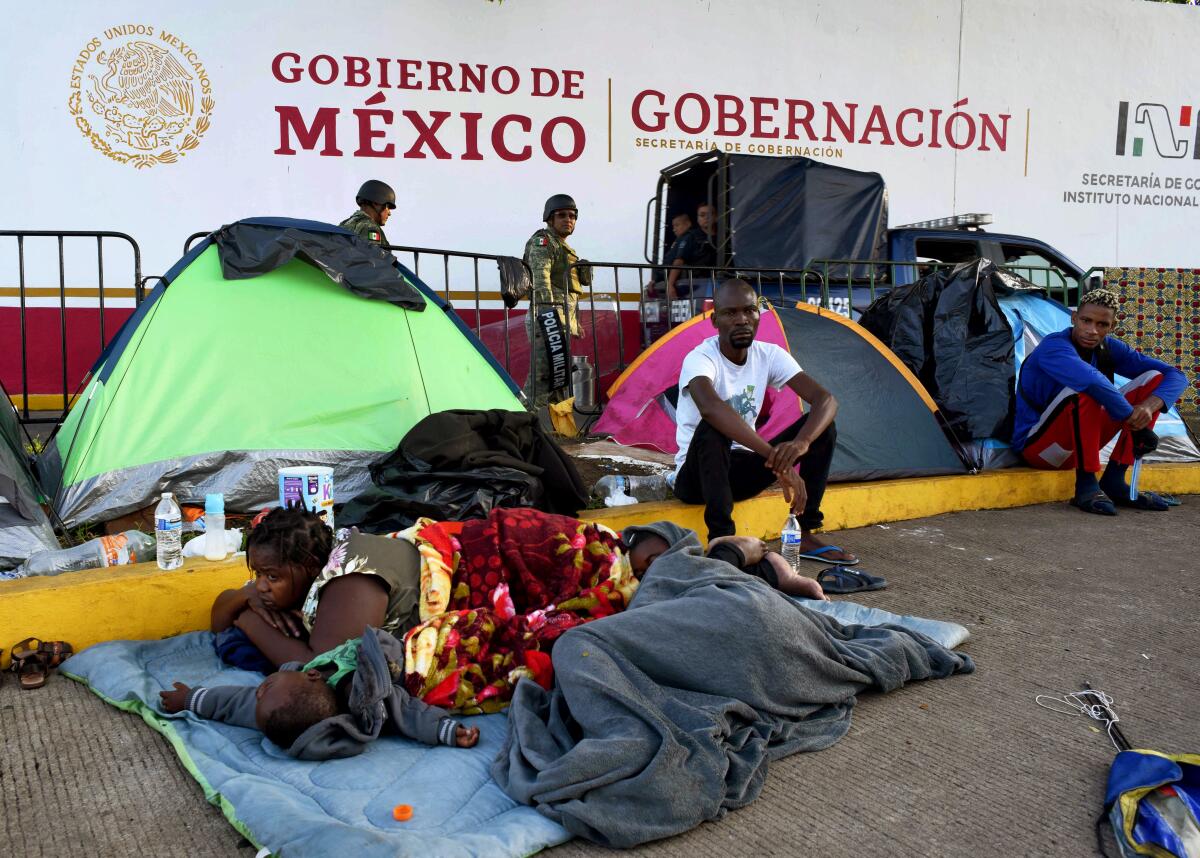
Most flew to Brazil, Ecuador or other countries in South America and then moved overland in buses, boats and on foot. Still haunting many is the harrowing trek through the legendary Darien Gap, among the world’s most impenetrable rainforests, between Colombia and Panama.
“We were in the forest in Panama, and I was very frightened,” recalled Julia Kyala, a spirited 12-year-old who picked up bits of Spanish and Portuguese — complementing her native Lingala and French — as she accompanied her mother from the Democratic Republic of Congo.
“I was swept into a river, I thought I would drown,” she said. “My mother came to rescue me, but she was also taken by the current. Then a man came and helped get us out and saved us.”
Her mother, Dina Kyala Buna, 26, rinsed beans in a pot of water outside the family tent as her daughter recounted the perilous passage.
Brandishing his cellphone, a burly Ghanaian man scrolled to a photo of what appeared to be a dead woman, half naked, sprawled on the rocks of a rushing river.
“This is what we saw in the jungle in Panama — dead people!” declared Osman, 33, who also declined to give his surname for security reasons. “We saw bodies! Many bodies!”
Eventually the migrants made their way to Guatemala and boarded smugglers’ rafts of wood planks and inner tubes to cross the Suchiate River into Mexico.
They intend to seek asylum at the U.S. border — if they ever get there. Their pleas for visas to cross Mexico have grown increasingly desperate.
One Congolese woman, Kumba Nsakala Miguelita, 32, gave birth in Tapachula on Sept. 4 and, in a bid for high-level assistance, legally named her new son Andres Manuel Lopez Obrador Nsakala Miguelita.
Informed of his namesake, Mexican President Andres Manuel Lopez Obrador, who has repeatedly vowed to respect the “human rights” of migrants, told reporters he was “very proud,” adding: “Migrants suffer a lot.”
But the president hasn’t reversed a previous vow not to “give in” to the Africans’ demands.
“It’s very difficult here,” Nsakala said the other day, fighting back tears as she struggled to keep her newborn cool inside her blue plastic tent.
The following day, Mexican authorities removed Nsakala and her child from the protest site and took them to a government-run shelter.
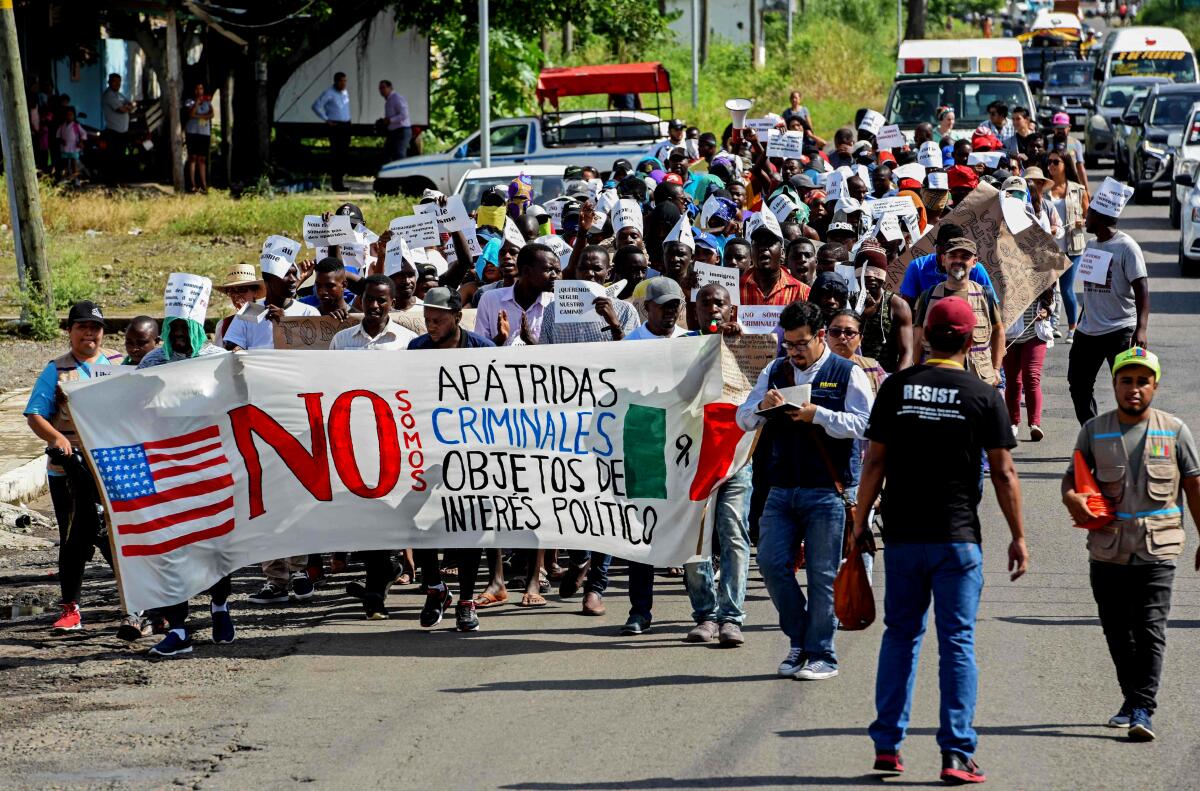
The protest here has sparked periodic clashes with Mexican authorities, who view the Africans as illegal squatters. The migrants cook on open campfires and metal braziers with coal and firewood. Women often pool cash to make market runs for food. Leaky tents and a pink plastic tarpaulin offer scant shelter during daily tropical downpours.
Mexico has provided little aid beyond setting up some portable toilets and an on-site ambulance for medical treatment. A single trash can, buzzing with flies, serves much of the encampment. A vending machine provides soft drinks for 20 pesos, or about $1.
Authorities have offered the possibility of asylum in Mexico, but the Africans have refused, said Marcelo Ebrard, the Mexican foreign secretary.
“In essence, what these people want is for Mexico to allow them to proceed to the United States with no legal status, the equivalent of saying there is no border,” he told reporters this month.
Indeed, few seemed inclined to join the bulging queues in Mexico waiting for refugee status, a process that can drag on for months.
“We don’t want to be in Mexico,” Isaac Junior, 28, from Cameroon, said in English. “We don’t feel safe here. We don’t speak the language.”
Some have reached the United States. In May, June and July, the Border Patrol apprehended more than 1,100 African migrants along a single 210-mile stretch of border in south Texas — compared to fewer than 300 along the entire southwest border in fiscal year 2018.
Their chances of being allowed to remain in the United States are low.
Under a new Trump administration policy, U.S. officials will not consider asylum applications from non-Mexicans arriving at the southwest border unless they have already filed for protection — and been turned down — in one of the countries that they passed through to get there.
That rule could dash the hopes of both those stuck here and hundreds of other Africans amassed in Mexican border cities from Tijuana on the Pacific to Matamoros on the Gulf.
Among this new vanguard of the African diaspora, there is much confusion and misinformation about fast-evolving U.S. immigration policies. Yet all are determined to move on.
“We just want to get out of here, and arrive to a better place,” said Rubi Tmamba, 17, a slim, towering native of Congo who hopes to enroll in a university and study international relations. “If not the United States, then maybe Canada. But we have come this far in search of this dream. We are not going back now.”
Special correspondents Liliana Nieto del Rio in Tapachula and Cecilia Sanchez in Mexico City contributed to this report.
More to Read
Sign up for Essential California
The most important California stories and recommendations in your inbox every morning.
You may occasionally receive promotional content from the Los Angeles Times.










